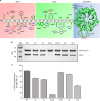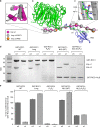Three-dimensional context rather than NLS amino acid sequence determines importin α subtype specificity for RCC1
- PMID: 29042532
- PMCID: PMC5645467
- DOI: 10.1038/s41467-017-01057-7
Three-dimensional context rather than NLS amino acid sequence determines importin α subtype specificity for RCC1
Abstract
Active nuclear import of Ran exchange factor RCC1 is mediated by importin α3. This pathway is essential to generate a gradient of RanGTP on chromatin that directs nucleocytoplasmic transport, mitotic spindle assembly and nuclear envelope formation. Here we identify the mechanisms of importin α3 selectivity for RCC1. We find this isoform binds RCC1 with one order of magnitude higher affinity than the generic importin α1, although the two isoforms share an identical NLS-binding groove. Importin α3 uses its greater conformational flexibility to wedge the RCC1 β-propeller flanking the NLS against its lateral surface, preventing steric clashes with its Armadillo-core. Removing the β-propeller, or inserting a linker between NLS and β-propeller, disrupts specificity for importin α3, demonstrating the structural context rather than NLS sequence determines selectivity for isoform 3. We propose importin α3 evolved to recognize topologically complex NLSs that lie next to bulky domains or are masked by quaternary structures.Importin α3 facilitates the nuclear transport of the Ran guanine nucleotide exchange factor RCC1. Here the authors reveal the molecular basis for the selectivity of RCC1 for importin α3 vs the generic importin α1 and discuss the evolution of importin α isoforms.
Conflict of interest statement
The authors declare no competing financial interests.
Figures








Similar articles
-
Nuclear localization signal and protein context both mediate importin alpha specificity of nuclear import substrates.Mol Cell Biol. 2006 Dec;26(23):8697-709. doi: 10.1128/MCB.00708-06. Epub 2006 Sep 25. Mol Cell Biol. 2006. PMID: 17000757 Free PMC article.
-
Crystal structure of importin-α3 bound to the nuclear localization signal of Ran-binding protein 3.Biochem Biophys Res Commun. 2017 Sep 23;491(3):609-613. doi: 10.1016/j.bbrc.2017.07.155. Epub 2017 Jul 29. Biochem Biophys Res Commun. 2017. PMID: 28760339
-
Chromatin-bound NLS proteins recruit membrane vesicles and nucleoporins for nuclear envelope assembly via importin-α/β.Cell Res. 2012 Nov;22(11):1562-75. doi: 10.1038/cr.2012.113. Epub 2012 Jul 31. Cell Res. 2012. PMID: 22847741 Free PMC article.
-
Diversification of importin-α isoforms in cellular trafficking and disease states.Biochem J. 2015 Feb 15;466(1):13-28. doi: 10.1042/BJ20141186. Biochem J. 2015. PMID: 25656054 Free PMC article. Review.
-
The intricate roles of RCC1 in normal cells and cancer cells.Biochem Soc Trans. 2022 Feb 28;50(1):83-93. doi: 10.1042/BST20210861. Biochem Soc Trans. 2022. PMID: 35191966 Review.
Cited by
-
Structural basis for importin alpha 3 specificity of W proteins in Hendra and Nipah viruses.Nat Commun. 2018 Sep 12;9(1):3703. doi: 10.1038/s41467-018-05928-5. Nat Commun. 2018. PMID: 30209309 Free PMC article.
-
The role of 3'UTR-protein complexes in the regulation of protein multifunctionality and subcellular localization.Nucleic Acids Res. 2020 Jul 9;48(12):6491-6502. doi: 10.1093/nar/gkaa462. Nucleic Acids Res. 2020. PMID: 32484544 Free PMC article.
-
The Great Escape: mRNA Export through the Nuclear Pore Complex.Int J Mol Sci. 2021 Oct 29;22(21):11767. doi: 10.3390/ijms222111767. Int J Mol Sci. 2021. PMID: 34769195 Free PMC article. Review.
-
Phosphorylation of importin-α1 by CDK1-cyclin B1 controls mitotic spindle assembly.J Cell Sci. 2019 Sep 23;132(18):jcs232314. doi: 10.1242/jcs.232314. J Cell Sci. 2019. PMID: 31434716 Free PMC article.
-
MERS-CoV ORF4b employs an unusual binding mechanism to target IMPα and block innate immunity.Nat Commun. 2022 Mar 25;13(1):1604. doi: 10.1038/s41467-022-28851-2. Nat Commun. 2022. PMID: 35338144 Free PMC article.
References
Publication types
MeSH terms
Substances
Grants and funding
LinkOut - more resources
Full Text Sources
Other Literature Sources
Molecular Biology Databases
Miscellaneous

